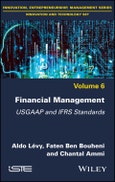Table of Contents
Contents
Introduction xi
Chapter 1. Value: IFRS vs. US GAAP 1
1.1. Value and the time 1
1.1.1. Cost of money, interest rate (nominal and real) 2
1.2. The time value of money: US GAAP 3
1.3. Future value and present value: capitalization and discounting in discrete time 4
1.3.1. Simple interest 4
1.3.2. Compound interest 9
1.4. US GAAP: future value and present value of rules of time travel 10
1.4.1. US GAAP: Effective annual rate and annual percentage rate 13
1.4.2. US GAAP: the determinants of interest rates 16
1.5. Annuities and unearned income: IFRS 19
1.5.1. Value of a sum of constant annuities 19
1.5.2. Current value of a sum of constant annuities 20
1.5.3. The updating of constant sums over an infinite period: the return 21
1.6. Calculating net present value and future value: US GAAP 22
1.6.1. Constant annuities of cash flows 22
1.6.2. Perpetuity 28
1.6.3. Growing cash flows 30
1.7. Market value 35
1.7.1. Relation required rate: value 36
1.7.2. Valuation of fixed rate debt 37
1.8. Actuarial rate of return 38
1.9. Value and risk 40
1.9.1. Probabilities and expected returns 40
1.9.2. Uncertain expected rate of return 41
1.9.3. Couple profitability, a risk: representation of expectation/standard deviation 41
1.9.4. Introduction to diversification: the case of two assets 42
1.9.5. Notions of diversification and non-diversifiable risk 43
1.9.6. Modeling randomized profitability with a two-factor model 45
1.10. Value and information 46
1.10.1. Information and uncertainty 46
1.10.2. Information efficiency 50
1.10.3. Exercises 50
Chapter 2. Diagnosis of Financial Statements: IFRS 57
2.1. Economic and financial analysis of business data 57
2.1.1. Principles and levels of study 57
2.1.2. Typology of financial analysis 61
2.1.3. Destination of the financial statement analysis 63
2.2. Financial reading of the balance sheet 66
2.2.1. Principles of financial statement preparation 67
2.2.2. Mechanism 70
2.2.3. Functions: financing, investment, exploitation and distribution 79
2.2.4. Investment study 95
2.2.5. Random analysis 114
2.2.6. Undetermined analysis 125
Chapter 3. Analysis of the Financial Structure: IFRS vs. US GAAP 131
3.1. Major functions of the French Accounting Plan 131
3.1.1. Assets 131
3.1.2. Current liabilities 133
3.1.3. Sustainable resources 135
3.1.4. Fixed assets 141
3.1.5. Calculation of global net revolving fund 142
3.2. The need for working capital requirement (WCR) 144
3.2.1. WCRE (or WCE) 145
3.2.2. WCREE 145
3.2.3. Recommendations on the need for working capital 147
3.2.4. WCR in days of HVAC 149
3.3. Net cash 154
3.3.1. Cash flow and the result are linked without being correlated 155
3.3.2. Analysis and recommendations 156
3.3.3. Financial analysis in market value 160
3.3.4. Presentation of the balance sheet in net asset values 162
3.3.5. Structural risks 164
3.3.6. The risk of imminent failure 164
3.3.7. Recommendations 164
3.4. Balance sheet analysis: US GAAP 164
3.4.1. Balance sheet features 165
3.4.2. Balance Sheet Diagnosis 170
Chapter 4. Analysis of Activity: Analysis of Profit and Loss Account: IFRS vs. US GAAP 179
4.1. Profitability and management performance 179
4.1.1. Intermediate Management Balances 180
4.1.2. Current exploitation 183
4.1.3. Non-operating current 191
4.2. Management indicators of the Banque de France 193
4.2.1. Partial or current indicators 194
4.2.2. Global indicators 198
4.3. Correspondences of FCA indicators – Banque de France 200
4.4. CAF cash flow 202
4.4.1. Principles 202
4.4.2. FCA approach 204
4.4.3. Analysis of the Order of Chartered Accountants 205
4.5. Renewed indicators (IFRS) of management 205
4.5.1. EBITDA 206
4.5.2. ROA 206
4.5.3. ROE 206
4.5.4. NOPAT 206
4.5.5. ROCE 206
4.5.6. COFROI 206
4.5.7. Free cash flow 207
4.5.8. EVA MVA 207
4.6. Income statement analysis: US GAAP 207
4.6.1. Case study 1: Mydeco Corporation 221
4.6.2. Case study 2: Atlas 224
Chapter 5. Analysis of Operational Profitability and Risk: IFRS 227
5.1. Profitability according to the chosen full cost model 228
5.1.1. Results Achieved in Full Cost by Analysis Centers and Unit Cost of Indirect Costs 228
5.1.2. Study 232
5.1.3. Results obtained in full cost by activity (Activity by Costing) 232
5.2. Budget based on normal activity 235
5.2.1. Activity 236
5.2.2. Budget for which indirect costs are unbundled in terms of being variable and fixed 236
5.2.3. Cost-effectiveness 236
5.2.4. Profitability 246
5.3. The breakeven point 249
5.3.1. Representation250
5.3.2. Indicators of profitability 252
5.3.3. Decision-making 253
5.4. Operating leverage 262
5.5. Return on equity 270
5.5.1. Economic profitability 271
5.5.2. Leverage 272
5.5.3. Financial Leverage 272
Chapter 6. Analysis by Ratios: IFRS 277
6.1. Composition and evolution ratios 277
6.1.1. Flow/Level 279
6.1.2. Level/Level 280
6.1.3. Levels/Flows 283
6.1.4. Flux/Flux 285
6.1.5. Flow/Level 286
6.1.6. Combination 287
6.2. Database 289
6.2.1. Activity ratios, profitability, balance, investment, debt, profitability of the Banque de France 290
6.2.2. Expeditious method of credit managers 300
Chapter 7. Analysis by Flux Tables: IFRS vs. US GAAP 305
7.1. Functional chart of the French Accounting Plan 306
7.1.1. Table of changes in total net working capital WC 306
7.1.2. Table of changes in working capital requirement 323
7.1.3. Synoptic diagram of the links between two-year financial statements 326
7.2. Financing table of the Banque de France 327
7.2.1. Functional balance 327
7.2.2. Cash flow statement 330
7.3. Cash flow statement of the French Association of Chartered Accountants 339
7.3.1. Net cash flows from operations 339
7.3.2. Net cash flows from investments 342
7.3.3. Net cash flows related to financing 342
7.3.4. Change in balance sheet cash position 343
7.3.5. Diagnosis of the financing table of the French Association of Chartered Accountants 343
7.4. Free cash flow table spanning several years 345
7.4.1. The method 347
7.5. Summary of the restatements of financing and flow tables 353
7.5.1. Table 353
7.5.2. Risk diagnosis 354
7.6. Statement of cash flow analysis: US GAAP 359
7.6.1. Features of cash flow statement 359
7.6.2. Cash flow statement diagnosis 362
7.7. Statement of stockholders’ equity 364
Conclusion 367
Glossary 369
Bibliography 379
Index 381








